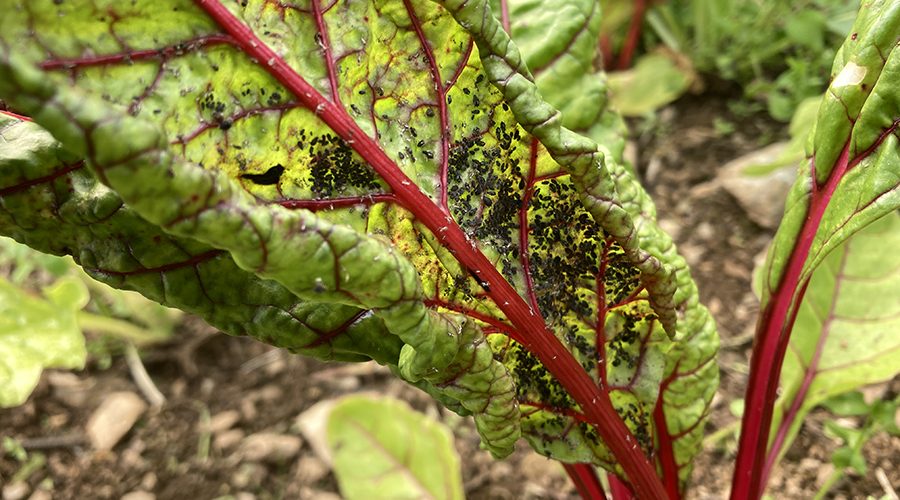In my garden, I have often had problems with blackfly on globe artichokes and on broad bean plants, but never on chard. I was very surprised, therefore, to see that a friend’s block of chard plants were completely infested. I actually don’t think I’ve ever come across blackfly on leaves like this before.
My friend’s plot, although not far away from me, is all grown undercover in a polytunnel, open at either end so not swelteringly hot, but not cool either. I can only imagine that it is this that makes the difference. It got me thinking about all the various growing conditions gardeners face, even potentially on a neighbouring allotment. A slightly different microclimate that can affect how things grow. It might be different soil, different prevailing wind, a little more shelter, a little less sun – all these things make big differences.
Another example is my next door neighbour’s garden – she grows exclusively in growbags lined up along the front wall of her home. My own garden is about ten metres away as the crow flies, but it is exposed and I grow in clay soil raised beds topped up with multipurpose compost. We halved a set of winter squash plants from Rocket Gardens this year, so the plants came from the exact same seeds etc, but her squash plants are huge, and with enormous abundant green leaves, where mine are smaller and the leaves more on the yellowing side. Such a big difference.
I thought it was worth talking about this because it’s worth knowing, that just because your neighbour’s squash look great, it doesn’t always mean that you’re ‘doing something wrong’ – I guess it’s just nice to remember that nature and the growing conditions play their own part. You might grow amazing beans but your potatoes always disintegrate, it’s just the way it goes. If you’re giving the plants good quality soil, providing the best conditions you can, and watering and feeding as best you can given drought, then that’s all you can do really.
Of course, then there are pests, like blackfly, where I started. For pests, I think you get to know what is common in your own garden, and over a few growing seasons, you get good at preventing those pests, finding the things that work for your plot – for me, it’s pigeons and caterpillars and slugs and I’ve got pretty good at keeping them to a minimum. For my friend with her polytunnel, it’s blackfly. If it’s blackfly for you, you could try a sticky yellow trap (like smearing a yellow bucket with vaseline) or you could plant a whole load of companions at the start of the season. Once an infestation has taken hold, I find strong squirt of water is usually enough to wash them off, and repeat once or twice a day to try and get rid of them.

